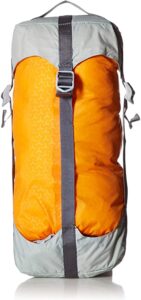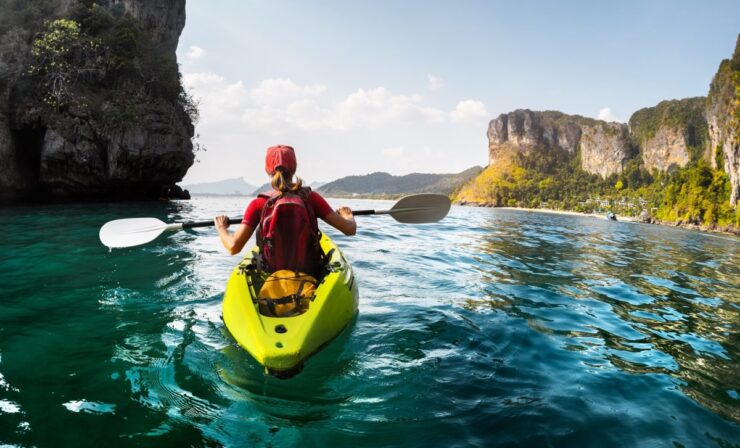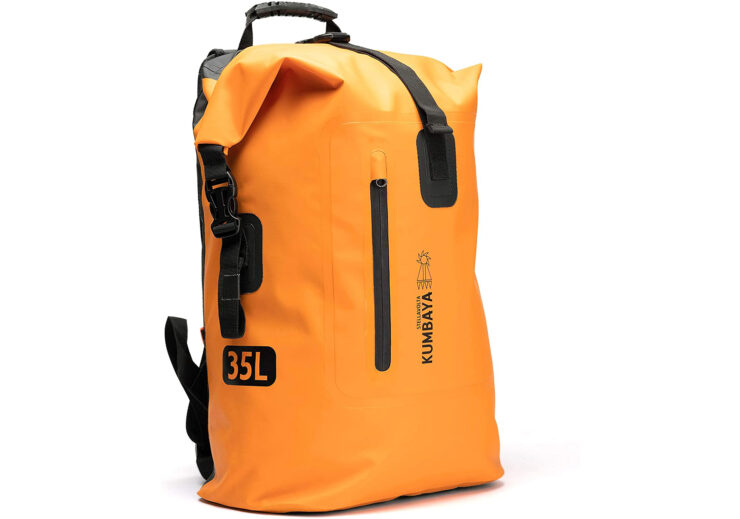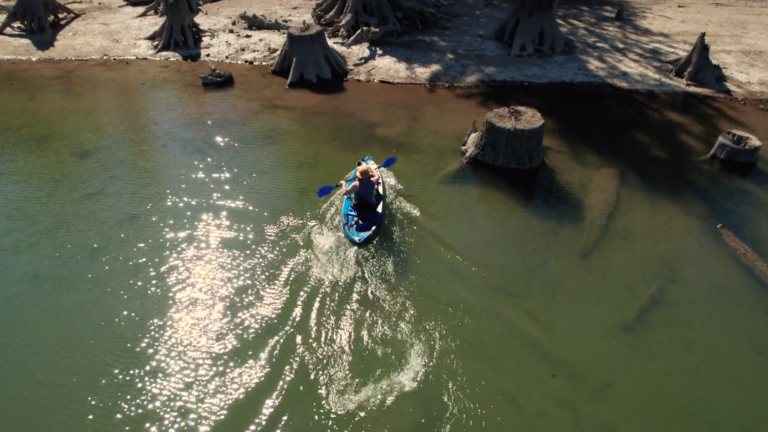Back in the day, if you wanted to keep your sandwich and change of clothes dry, you used waxed canvas bags or a sealable tin can. But of course, this type of storage was rife with very obvious problems.
However, as plastic became a part of our everyday life, it became a natural substitute. It was in fact the precursor to what seafarers use these days to keep their essential items dry and, in most cases, afloat: the dry bag, aka dry sacks and watertight duffel bags.
Without a shadow of a doubt, dry bags are the way to go if you want to keep your gear dry, whatever your watersport might be. Let’s take a closer look at some good kayaking dry bags, their features and more.
Table of Contents
ToggleOur Top Picks
1. The SealLine Discovery Deck Dry Bag (10L)
Check on Amazon
Check on PlanetsHoup
This neat 10-liter bag comes with a manufacturer’s lifetime warranty and it’s trademarked PurgeAir system means you can easily expel any trapped air inside it once it’s full, making it compact and easy to stow. It is available in a wide range of vivid colors.
It features welding seaming as opposed to just standard stitching so if it’s properly cared for, there’s no reason it won’t keep the contents dry for as long as you own it.
Although I’m not a huge fan of the bandoleer-style strap, it works just fine and is comfortable enough for leisure use. Unlike some bags of the same size and similar price range, the Discovery has a very sturdy side-strap too, which some users will appreciate.
Although I don’t really see the actual benefit to translucent materials, it’s actually one of the bag’s strong selling points as it allows you to see what’s inside and to locate an article without excessive rummaging.
In line with current eco-friendly trends for this type of product, the Discovery is PVC-free. If it’s a cheap yet sturdy bag you’re on the hunt for, you can’t really go wrong with this dry bag.
- Durable and Waterproof
- Lightweight and PVC-Free
- Easy to Use
- Versatile Carrying
- Visibility and Accessibility
- Material may be sensitive to rubbing against rough surfaces.
2. The NRS Ether HydroLock Dry Bag (5L)

Check on Amazon
Check on NRS
NRS have been in the outdoor gear and equipment game for quite a while now and it shows. They clearly take R&D seriously in all of their products and understand that even leisure users expect quality and durability for their dollar.
I have a PFD made by them and it has stands up to quite a lot of abuse. This is one of the smallest dry bags you’ll find on the market and is a perfect choice if you’re not planning to take much gear with you.
There is also a two and a three-liter version of the same product but any smaller than five liters just isn’t practical for kayakers, in my view. You’re not going to cram much into it but there’s enough space for a change of t-shirt and shorts and a couple of other small essentials.
The whole range of NRS HydroLocks have a urethane see-through window on it so you know where to find exactly what you’re looking for. However, the flip side of this little window is that it is certainly more fragile than other bags that don’t boast this particular feature.
The HydroLock has a zip-seal closure, which the manufacturer assures us provides 100% waterproof protection. The bag has the standard roll-down closure system (once it’s zip-sealed) but the HydroLock lets you flair the top so it doubles as a handle. That’s a neat feature.
It certainly isn’t military-grade material and does require a bit more TLC than some of its competitors but at its price, it’s an inexpensive option for kayakers who don’t need to carry too much gear with them. Rest-assured, it’ll keep the contents bone-dry even when submerged in shallow water.
- Lightweight and Durable:
- Welded Seams
- Clear Urethane Window
- Roll-down StormStrip Top
- Handy Attachment Point
- Thin Material
- Vulnerable to Contact with Chemicals
3. The ALPS Mountaineering Dry Bag (2, 5 and 10L)
Check on Amazon
Check on Cabelas
Check on ALPS
You can actually get three for the price of one. The pack comes with a two, five and ten-liter bag, all with exactly the same features: roll-down top, welded seams and PVC waterproof protection. It certainly isn’t a top-of-the-range kit but you’re getting value for money.
It’ll keep your gear dry and the little two-liter bag is perfect for your phone or other tech as you effectively get double the protection if you store the small bag inside one of the two larger ones. It has a flat bottom, which is a feature you’ll appreciate when the large bag is full because, unlike similar bags, it won’t fall over all the time!
I would avoid immersing this bag entirely for long periods of time as it’s really just designed to protect the contents from ‘moisture and a variety of wet conditions, as per the manufacturer’s specs. But don’t be put off: the Torrent is a neat bag that will do the job it was designed for at a very affordable price.
- Highly Waterproof
- Easy to Fill
- Durable and Secure
- Multiple D-ring Attachments
- Variety of Sizes and Colors
- Some users noted a strong vinyl smell from the material.
- Material is Stiff
4. The Pacsafe Dry Waterproof Safe Pack (15L)

This bag is a different story altogether: apart from keeping your gear dry, it also keeps it safe, hence the higher price. At the time of writing, REI are selling it for $79, which is nothing short of bargain for this particular product.
So, why the heftier price tag? Well, it’s clearly not targeting just the day-tripping leisure kayaker. The Safe Pack is designed to take a lot more abuse than cheaper bags.
Its slash-proof material protects against sharp rocks and jagged edges and its comfortable backpack/rucksack design means that you can take this bag on a trek with you if you’re combining your kayaking with some on land adventures.
It features a roll-down sealing system that works in much the same way as other bags described in this article but the Safe Pack also has a lockable (combination – no key to lose) stainless steel interior cage.
It also boasts RFID material, which in case you’ve never heard of that before, protects you from electronic identity theft by blocking radio frequencies from communicating with your ‘phone or the chip on your credit card.
Completely useless when you’re out on the water with your buddies but imagine you’ve stopped off for a bite to eat and your bags are beside your table or at your feet.
The bad guys know for sure that you’ve got some goodies in there and these days it’s not entirely unreasonable to take certain extra precautions. If you’re planning to kayak and camp in places you’ve never visited before or need to take public transport to get to or from your port of departure, suddenly RFID protection won’t seem like such a crazy idea.
It’s a 15-liter bag, which is about as big as I’d go. Any bigger than that and the bag would be possibly too cumbersome for kayaking.
If you’re planning to do some more advanced, longer trips to places you are unfamiliar with, the Safe Pack is certainly worth considering for that extra peace of mind.
- Features 360-degree stainless steel wire mesh
- Lockable to Fixtures
- Compact & Portable
- Water-Resistant Fabric
- Offers peace of mind both indoors and outdoors by securing valuables
- Some users found the included lock to be of lower quality
5. The SealLine Blocker Compression Dry Sack (10L)
Check on Amazon
Check on Cabelas
Check on Kiky
This bag allows you to squeeze a little more into it than other ten-liter bags thanks to its compression system. SealLine call it a ‘PackTight’ packing system and it’s a little like sitting on a packed suitcase and wrapping a belt around it except that the Blocker does the same thing with a lot more elegance and manages to provide up to 610 cubic inches storage space.
When I wrote that the R&D departments were brainstorming ideas to provide their customers with new and innovative ideas, this is what I was referring to. It’s basically a ten-liter bag that, due to its compression features, allows you to really cram in more than other bags of the same size.
In fact, this particular product is ideal for packing certain types of sleeping bags. The roll-top bag has what the manufacture terms ‘a continuous compression system’ that, once packed and closed, allows you to compress either end by pulling on the four side straps. SealLine’s PurgeAir means you’ll be able to keep the bag as compact and dry as possible.
With a lifetime warranty and a price tag that won’t break the bank, you can’t go wrong.
- Efficient Compression
- Space-Saving Design
- Durable and Waterproof
- Secure Seal
- Versatile Sizes
- Some users prefer a larger diameter for easier stuffing, so checking the dimensions is advisable.
Why Are Dry Bags Essential For Kayaking?

There are numerous reasons for purchasing a dry bag. It’s not just a capricious addition to your kit; it’s become almost a necessity and can in fact increase safety on the water and get you out of sticky situations.
Apart from keeping your change of clothes and towel dry, you can use them to store other essential items such as water, food and your phone. If you choose one in a bright color, it can also help locate you in the water. Prices can range from under $10 for basic, small leisure models to over $500 for military-grade duffle bags.
6 Things To Look For In A Dry Bag
Before you acquire one, think carefully about the type of use it’s going to get and consider the following 6 factors:
1. Dry Bag Capacity
Dry bags usually measure capacity in liters. For leisure kayaking use, a ten-liter bag is usually enough. If it’s any larger than that, your bag may be too bulky for your stowing comfortably in your kayak or canoe. Don’t overdo – just pack the essentials.
2. Beware Of The Extra Features
Dry bags don’t usually have lots of pockets or ‘neat features’. The more add-ons it has, the harder it is to waterproof. If it does have lots of nooks and crannies and is well sealed, it’ll probably cost you a lot more that a more basic bag that will cover the average user’s needs.
3. Color Choice Is Important
Go for bright colors. When it comes to purchasing anything for use in the sea or lakes etc., I avoid ‘natural’ colors and go more for bright orange, yellow or red.
Anything you add to you or your craft that will make you more visible to other seafarers is a bonus.
4. Pick Good Materials
If you practice kayaking in an area with rocky shores and not too many sandy beaches, consider purchasing a dry bag with a tough exterior.
Over time, and especially with the cheaper to mid-range models, scuffing can occur on the corners and edges of the bag if it’s in regular contact with rough surfaces.
5. Make Sure It’s Actually Waterproof

If you’re considering storing your phone or other electronics in your bag, make sure the manufacturer assures (or even better, guarantees) that it will not get wet in the bag.
Even the cheapest bags do a pretty good job at keeping everything dry but do your research and look for other users’ opinions.
Some bags are sold as dry bags but are in fact just splash proof. That may be adequate for the type of sport you practice and the conditions you practice it in but don’t expect much from your bag if it goes in the water.
I’ve seen bags become waterlogged and sink.
6. Check Out The Straps
Don’t just focus on the overall design and color of the bag. Check out the straps’ durability (usually at the top or side of the bag) and other carrying options.
Some are designed to be carried much like a backpack, which can be handy if you’re going to combine kayaking/canoeing with a spot of hiking. Bandoleer straps are fine for short walks but not recommendable for a couple of hours in the forest, as they tend to slide down to your hip.
What’s on the market: 4 Types Of Dry Bags
As happens in any industry, when a product becomes popular or fashionable, manufacturers tend to saturate the market with all sorts of sizes, colors and designs, the sheer variety of which can actually confuse a first-time buyer.
As mentioned previously, you need to do some research before purchasing and narrow your choice down a little before breaking out the credit card.
It’s important to remember that this type of bag is rarely exclusively designed for kayaking. In fact, kayaking dry bags with their gun bag design generally get the worst reviews from users.
There are very few on the market at the time of writing. The majority of products usually highlight features such as size, durability and weight (when empty) with some importance given to how eco-friendly their products’ material is.
The use of PVC in watersports material is gradually being phased out around the world so it’s probable that you’ll come across terms you hadn’t heard of before such as ‘PVC tarpaulin’, which is an eco-friendly PVC.
The market has adapted supply to demand and the demand is ample and varied! You can find bags for pretty much any sport or outdoor activity you can think of.
Whatever your choice, you might want to consider environmentally friendly options and in doing so encourage manufacturers to produce bags that help protect the environment we practice our watersports in.
Remember: every time you pay for a product, you’re casting a sort of vote. By opting for eco-friendly bags, you’re sending a message to manufacturers.
1. Roll Tops Dry Bag

Perhaps one of the most common all-rounder bags. They come in sizes from five liters right up to 300 liters and the basic idea is the same: a tubular bag with a few inches at the top part that you role down and seal with clasps of some description on either side and the front of the bag.
They’re usually carried with a side strap or a ‘handle’ at the top or on the side or have a ‘bandoleer’ style strap. These are the most popular in the boarding, kayaking, and canoeing community.
2. Rucksacks/backpacks

Very similar to roll tops but with the usual straps you’d expect to find on your standard backpack. They’re very handy if you decide to combine your kayaking with some hiking.
Be sure the straps are wide and comfortable if you opt for this type of dry bag.
3. Holdalls/duffel bags

These are the type of bags you’d use to keep your gym gear in and are not practical for kayaking given their size and design.
4. Tech dry bags

These are the small bags you typically see people store their ‘phones in at the beach or aboard a boat. Given that 90% of dry bags commercially available are not submersible or at least offer not guarantees, it might be a good idea to pop your expensive tech into a small bag and then into a larger one, just in case.
I’ve had a couple of dry sacks over the years and have found that spending more money on one doesn’t necessarily guarantee that it’s going to be better than cheaper counterparts. The one I use for kayaking and boarding is very similar to the bag I have for sailing except in size. My sailing bag usually has to accommodate a lot more gear.
Basics: How To Properly Pack A Roll Top Dry Bag
The 10 liter bag pictured below is what I use for kayaking and it holds everything I could possibly need for a three to four-hour trip, phone included. It retails very cheap, and ticks all the boxes for me.
I tested it before putting my valuables in it and I was pleasantly surprised. When packed with food, water, a towel, and a phone, it’ll sit on the water for longer than I was prepared to wait, so, all good! I’m confident it won’t let me down if we end up in the water for any longer than that.
FAQs
Why is it important to choose an eco-friendly dry bag?
Choosing an eco-friendly dry bag is important as it helps in reducing environmental impact and promoting sustainability. By opting for eco-friendly options, consumers encourage manufacturers to produce products that are less harmful to the environment, particularly the water bodies where water sports are practiced.
Can dry bags be used for activities other than water sports?
Yes, dry bags are versatile and can be used for a variety of outdoor activities beyond water sports, such as hiking, camping, and traveling, to protect belongings from water, dust, and dirt.
How can I determine the right size of a dry bag for my needs?
To determine the right size, consider the items you plan to store in the bag and the activity you’ll be using it for. For short trips or minimal gear, smaller bags may suffice, while longer trips or larger items may require bags with larger capacities. Assessing your specific needs and preferences will help in selecting the right size.
Are all dry bags completely waterproof and submersible?
Not all dry bags are completely waterproof or submersible. Many dry bags are designed to protect against splashes and brief immersion but may not guarantee protection if submerged for extended periods. It is crucial to read the product specifications and reviews to ensure the bag meets your waterproofing needs.
Can I store electronic devices in a dry bag?
Yes, dry bags can be used to store electronic devices to protect them from water, but it is recommended to use a smaller, specialized tech dry bag for added protection, especially since many commercially available dry bags do not guarantee submersion protection.
Is it necessary to spend more money to get a high-quality dry bag?
Spending more money does not necessarily guarantee a higher-quality dry bag. It is essential to consider the bag’s features, material, design, and user reviews to determine its quality and whether it meets your specific needs. Comparing different options within your budget can help you find a bag that offers the best value for money.
Last Words on Kayaking Dry Bags…
Dry bag popularity has grown with the general boom in watersports on our coasts and inland waterways. I first came across them in the mid-2000s when I was crewing on a particularly lively sailboat on the lakes of Ireland. After a couple of broaches in blustery winds, the boat was pretty waterlogged and we were all feeling rather miserable and damp.
On our way back to port after the races, one of the crew smugly ‘unrolled’ her dry bag and pulled out her change of bone-dry clothes. The rest of us were in a sort of jealous awe! Since then, there’s usually one dry bag per crewmember onboard and the standard backpacks and sailing bags are now left on shore.
On your usual go-to website or marine provider the range of products available is simply mind-blowing. These bags have become commonplace over the last decade and can be found onboard anything that floats, from large yachts and sailboats to paddleboards.
One thing is for sure – I’d never go kayaking without a dry bag!
Adelaide Gentry, a seasoned kayaking enthusiast and expert, is the driving force behind KayakPaddling.net. With over a decade of experience navigating the world’s most challenging waterways, Adelaide combines her passion for adventure with a deep knowledge of kayaking to provide insightful and practical guidance for paddlers of all levels.
Related Posts:
- 16 Best Kayak For Beginners 2024 - Kayaking Adventure Gear
- Heavy Duty Fishing: 11 Best Rods And Reels For Big Fish 2024
- 12 Best Beach Wagons & Carts 2024 - For All-Terrain
- 20 Best Inshore Spinning Reels 2024 - Capturing All…
- 10 Best Fish Finders Under $200 2024 - Top Affordable Picks
- 16 Best Kayak Fishing Paddles 2024 - Affordable Fishing Gear












